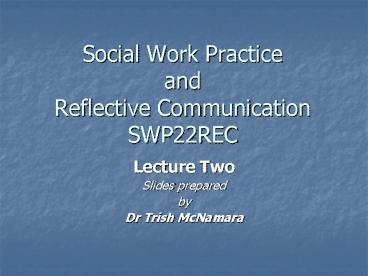Social Work Practice and Reflective Communication SWP22REC - PowerPoint PPT Presentation
1 / 26
Title:
Social Work Practice and Reflective Communication SWP22REC
Description:
What is the science of communication? Making sense of the messages ... First year apprentice wanted for trendy North Carlton salon. Call Tuesday after 10am. ... – PowerPoint PPT presentation
Number of Views:178
Avg rating:3.0/5.0
Title: Social Work Practice and Reflective Communication SWP22REC
1
Social Work Practice and Reflective
Communication SWP22REC
- Lecture Two
- Slides prepared
- by
- Dr Trish McNamara
2
What is the science of communication?
- Making sense of the messages given and
received through - Physiology of the senses
- Psychology of cognition
- Psychology of emotion
- Linguistics
3
Perception
- Self
- Others
- Culture
- Empathy
- Adler and Rodman (2006) pp 33-73
4
Perception
- Perception is information which is taken
- which is taken in by the senses, processed by
the brain, stored in memory and which produces
some form of physical and mental activity. - Ellis and McClintock (2nd ed., 1994) Ch 1
5
Sensory information
- Smell taste touch (experiment)
- Absolute sense thresholds
- Brain processes interpreting the information
gained from our senses - The Muller-Layer illusion
- Ellis and McClintock (2nd Ed, 1994) Ch 1.
6
Perception (cont)
- Storing in memory (round red object apple ball
cherry, Pythagoras theorem) - Expectancy sets (glowing red pot is hot can lead
to prejudice dislike of people or group of
people) - Subliminal perception (at the extreme limits of
human senses body odour/ pupils dilate) - Selected perception (regular flashing vs
intermittent flashing adverts accommodating to
sleeping near busy road)
7
Communication models
- Maps, flow charts, diagrams
- Attempt to describe a theory, a process, an event
of communication - Ellis and McClintock (1994) p.64
8
The Shannon-Weaver Model(Transmission-Process)
- S - T - R - D
- send transmit receive dispatch
9
Key concepts of Shannon and Weavers Model
- Channel of communication (post or phone)
- Coding or encoding (English or Japanese)
- noise (anything that disrupts or interrupts
communication flow) - Channel overload (everyone talking at once)
- Redundancy
- Entropy
10
Redundancy
- Jack and --- went up the hill
- Mary --- a little lamb
- Old King Cole was a --- old soul
11
Entropy
- a measure of the disorder within any system
12
A Morning!B Morning!A Nice day, isnt it?B
For a murder..
- Last line is entropic unexpected,
unpredictable, difficult to decode
13
Semiotic School of Communication Theory
- Concerned with how we interpret and ascribe
meaning to the messages sent
14
Peirces Model
- Focuses upon the interconnectedness between the
sign, - the object and the interpretant
15
Newspaper advertisement
- First year apprentice wanted for trendy North
Carlton salon. - Call Tuesday after 10am. Ph 93476666
16
Words and meanings!
- Hairdresser Hello
- Caller May I speak to Tuesday?
- Hairdresser There is no one by that name working
here - But the ad said call Tuesday!
- Hairdresser (and listening audience) silenced by
laughter..
17
Can you think of any context in which the word
dog is used to describe anything but a four
footed animal?
18
Perceiving the self
- Moods and feelings
- Appearance and physical condition
- Social traits
- Talents you possess or lack
- Intellectual capacity
- Strong beliefs
- Social roles
- Adler and Rodman (2006) p. 48
19
Language and meaningAdler and Rodman (2006)
Chapter 3
20
The nature of language
- Language is symbolic
- Meanings are in people, not words (John Howard on
anti- terrorism laws) - Language is rule governed
21
Language is rule governed
- Phonological rules the sound when pronounced (
buch, book) - Semantic rules the specificity of meaning
(Tuesday) - Pragmatic rules helps us to shape the meaning
to the context
22
The power of language
- Language shapes attitudes
- Language reflects attitudes
23
THE WAR AGAINST TERRORISMTHE WAR AGAINST
TERRORTHE WAR AGAINST IRAQTHE WAR IN IRAQ
24
Language reflects attitudes
- Power
- Affiliation
- Attraction and interest
- Responsibility
- Adler and Rodman (2006) pp.85-88
25
Troublesome language
- Misunderstanding (no)
- Evasive language (I am very sympathetic to the
people of your street becoming desensitized to
hate words - A and R p97) - Disruptive/angry (No! You are not sympathetic!)
- Relative words (large and small)
- Slang and jargon (bacon and eggs legs in
Cockney) - see
- Don Watsons
- (2003) Death Sentence The decay of public
language - and
- (2004) Weasel Words Contemporary cliche?s, cant
and management jargon
26
Gender and language
- Content (sport, media personalities vs family,
weight, food and fashion???) - Reason for communicating (women need same sex
conversation offer/receive support men want
same sex conversation to assert
authority/viewpoint) - Conversational style (fluid, dynamic, aggressive,
strong vs tentative and aesthetic) - Non-gendered variables (cooperative versus
competitive feminist versus non-feminist) - Sex roles (feminine speakers are more tentative
and inclusive masculine speakers are dominant
and aggressive) - Adler and Rodman pp.98-100































